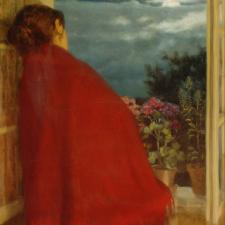The period of the turn of the twentieth century was one of the most turbulent and dynamic stages in the development of fine art, which was becoming an increasingly important part of life in continental Europe and elsewhere at that time. The belle époque, as the period from the 1890s to the beginning of the First World War is retrospectively referred to, provided generous room for the establishment of artistic movements and trends such as symbolism, art nouveau and impressionism, which originated mainly in France but soon gained international significance. Artists began to explore new themes for their work that reflected the contemporary atmosphere in society, from the weariness and scepticism of the end of the century to the belief in the social progress that the coming new age would hopefully bring.
Among these moods, unconventional interpretations of religion, spiritualism and esotericism, fairy tales and fantasies played a key role; but it also reflected social criticism of society, labour, the countryside and its folklore, the modern way of life in the city, the new possibilities for leisure offered by sports, etc. Among the painting genres, landscape painting was becoming a privileged discipline that responded to many of these stimuli and was strongly influenced by the aforementioned symbolism, art nouveau and impressionism. It was at this time that a new wave of emancipation of Czech art began to rise, which worked hard to integrate more strongly into international structures.
The collection of Czech art of the fin de siècle period in Západočeská galerie v Plzni (the Gallery of West Bohemia in Pilsen, GWB) is, both in terms of the quantity and the quality, one of the best not only within the collection of the gallery but undoubtedly also in the context of public collections in the Czech Republic. It is worth noting that art of the period in question had been prominently represented in the collections of institutions that had existed in the region before the founding of the GWB in 1954, such as the Museum of Decorative Art of West Bohemia in Pilsen, Pilsen Municipal Art Gallery and the Bank of Pilsen, from where it was subsequently transferred to our gallery and formed an important basis for, among other things, the collection of art from the turn of the twentieth century. The most interesting collections from that period in terms of number and quality belong to Alfons Mucha, Vojtěch Hynais, Václav Brožík, Luděk Marold, Maxmilián Pirner, Jan Preisler, František Kupka, Max Švabinský, Jaroslav Špillar, Josef Mandl, Jaroslav Panuška, Josef Váchal, Antonín Hudeček, Antonín Slavíček and others who represented a wide spectrum of opinion on the art scene of the time. The collection of works of Czech art of the fin de siècle period has been systematically expanded over a long period of time. Purchases from antique shops and private collectors, and in the post-1989 period also from auction galleries, have been a source of new acquisitions. One of the most interesting acquisitions is undoubtedly the series of sketches by František Kupka for the world-famous series Money from 1901, purchased in 1971 from Adolf Hoffmeister, an important cartoonist, diplomat and artistic life tycoon of both interwar and post-war Czechoslovakia; another example is the recently acquired, long missing work Dawn After Good Friday by Emanuel Krescenec Liška, which is not only one of his largest but also one of the last paintings he worked on until his untimely death in early 1903.
|
|







